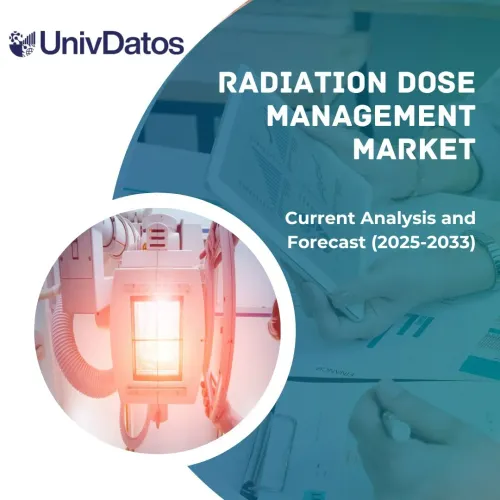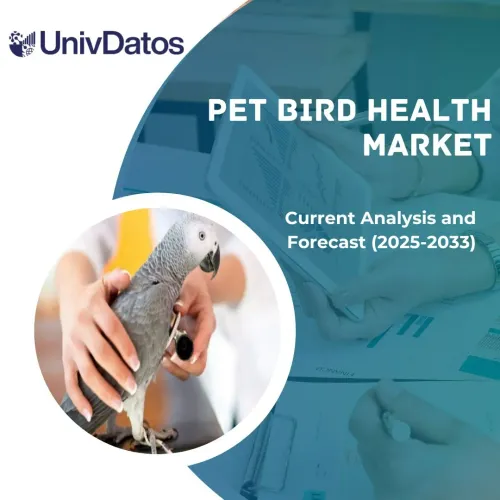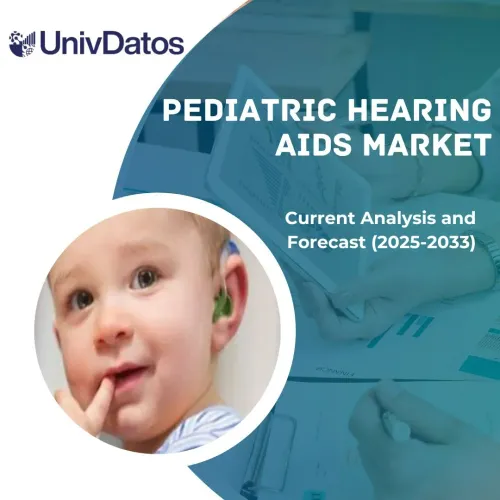- Trang chủ
- Về chúng tôi
- Ngành
- Dịch vụ
- Đọc
- Liên hệ với chúng tôi
Thị trường Trí tuệ nhân tạo (AI) trong Chẩn đoán Y tế: Phân tích và Dự báo Hiện tại (2021-2027)
Nhấn mạnh vào Thành phần (Phần mềm và Dịch vụ); Ứng dụng (Chẩn đoán In-vivo và Chẩn đoán In-vitro); Người dùng cuối (Bệnh viện, Phòng thí nghiệm & Trung tâm Chẩn đoán và Những người khác); Khu vực/Quốc gia
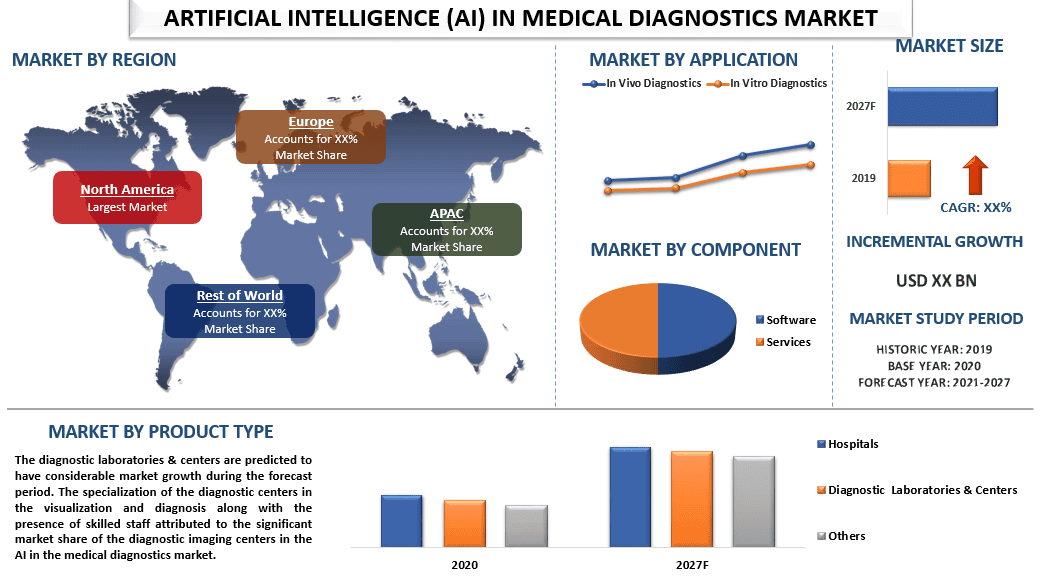
Thị trường Trí tuệ nhân tạo (AI) trong Chẩn đoán Y tế Toàn cầu dự kiến sẽ tăng trưởng với tốc độ CAGR khoảng 28% trong giai đoạn dự báo (2021-2027).Trí tuệ nhân tạo (AI) sử dụng các chương trình máy tính phân tích một lượng lớn thông tin để tìm hiểu cách giúp đưa ra quyết định hoặc dự đoán. AI đã cách mạng hóa lĩnh vực chăm sóc sức khỏe do khả năng ra quyết định nhanh hơn và chính xác hơn.
Sự gia tăng tỷ lệ mắc các bệnh mãn tính và số lượng nhập viện đã buộc các cơ sở y tế phải phát triển và giới thiệu các cơ sở chẩn đoán tiên tiến. Hơn nữa, dân số già tăng nhanh chóng và các bệnh liên quan đến tuổi tác ngày càng tăng trong số họ góp phần vào sự tăng trưởng thị trường của AI trong chẩn đoán y tế để chẩn đoán nhanh chóng và chính xác.Ví dụ, theo Liên hợp quốc, dân số từ 60+ tuổi là 962 triệu vào năm 2017, gấp hơn hai lần so với năm 1980 là 382 triệu. Số người cao tuổi dự kiến sẽ tăng gấp đôi vào năm 2050 và đạt gần 2,1 tỷ người trên toàn thế giới. Hơn nữa, sự phát triển liên tục trong các kỹ thuật trực quan hóa y tế cũng chịu trách nhiệm cho sự tăng trưởng thị trường của AI trong chẩn đoán y tế.
Siemens Healthineers, Zebra Medical Vision Inc., Riverain Technologies, Vuno Inc., Aidoc, Neural Analytics, Imagen Technologies, Digital Diagnostics, Inc., GE Healthcare và AliveCor Inc., là một số doanh nghiệp nổi bật hoạt động trong thị trường trí tuệ nhân tạo (AI) trong chẩn đoán y tế. Một số thương vụ M&A cùng với quan hệ đối tác đã được các doanh nghiệp này thực hiện để tạo điều kiện cho khách hàng với nhiều loại thiết bị trí tuệ nhân tạo (AI) trong chẩn đoán y tế.
Thông tin chi tiết được trình bày trong Báo cáo
“Trong số Thành phần, phân khúc Phần mềm chiếm phần lớn”
Dựa trên thành phần, thị trường được phân loại thành phần mềm và dịch vụ. Phân khúc phần mềm chiếm thị phần đáng kể vào năm 2020 và dự kiến sẽ tăng trưởng trong giai đoạn dự báo. Số lượng các trường hợp mắc bệnh truyền nhiễm ngày càng tăng nhanh chóng gây áp lực lên các cơ sở chẩn đoán y tế để xét nghiệm, từ đó làm tăng nhu cầu về AI dựa trên phần mềm để chẩn đoán và phân tích nhanh chóng kết quả.Ví dụ, theo WHO, tỷ lệ mắc bệnh sốt xuất huyết trên toàn cầu đã tăng lên đáng kể với khoảng một nửa dân số thế giới hiện đang có nguy cơ. Ước tính có 100-400 triệu ca nhiễm bệnh mỗi năm.
“Trong số Ứng dụng, phân khúc In vivo chiếm phần lớn”
Dựa trên ứng dụng, thị trường được phân khúc thành in vivo và in vitro. In vivo chiếm thị phần đáng kể vào năm 2020 và dự kiến sẽ chứng kiến sự tăng trưởng đáng kể trong giai đoạn dự báo. Điều này chủ yếu là do sự gia tăng tỷ lệ mắc các bệnh mãn tính và các biến chứng thai kỳ ngày càng tăng góp phần vào sự tăng trưởng thị trường đáng kể của phân khúc in vivo trong thị trường chẩn đoán dựa trên AI. Ví dụ, theo who, mỗi ngày, 800 phụ nữ chết vì các biến chứng khi sinh và một phụ nữ mang thai từ một nước đang phát triển có khả năng mắc các biến chứng liên quan đến thai kỳ cao gấp 36 lần so với một phụ nữ mang thai từ một nước phát triển.
“Trong số Người dùng cuối, phòng thí nghiệm & trung tâm chẩn đoán chiếm phần lớn”
Dựa trên người dùng cuối, thị trường được phân khúc thành bệnh viện, phòng thí nghiệm & trung tâm chẩn đoán và những người khác. Các phòng thí nghiệm & trung tâm chẩn đoán dự kiến sẽ có sự tăng trưởng thị trường đáng kể trong giai đoạn dự báo. Điều này là do sự chuyên môn hóa của các trung tâm chẩn đoán trong hình ảnh và chẩn đoán cùng với sự hiện diện của đội ngũ nhân viên có trình độ. Hơn nữa, việc tích hợp công nghệ tiên tiến như thiết bị dựa trên AI và hồ sơ bệnh án điện tử là yếu tố thúc đẩy sự phát triển của các trung tâm chẩn đoán hình ảnh trong trí tuệ nhân tạo (AI) trong thị trường chẩn đoán y tế.Ví dụ, tại Ấn Độ, Mahajan Imaging đã khai trương một trung tâm xuất sắc tích hợp trong chẩn đoán ở Delhi để cung cấp phương pháp điều trị chính xác và cá nhân hóa cho bệnh nhân. Trung tâm mới được trang bị một bộ phận R&D và một công ty khởi nghiệp AI.
“Bắc Mỹ đại diện cho một trong những thị trường lớn nhất về Trí tuệ nhân tạo (AI) trong thị trường Chẩn đoán Y tế”
Để hiểu rõ hơn về động lực thị trường của Trí tuệ nhân tạo (AI) trong thị trường Chẩn đoán Y tế, một phân tích chi tiết đã được thực hiện cho các khu vực khác nhau trên toàn cầu bao gồm Bắc Mỹ (Hoa Kỳ, Canada và Phần còn lại của Bắc Mỹ), Châu Âu (Đức, Pháp, Tây Ban Nha, Vương quốc Anh, Ý và Phần còn lại của Châu Âu), Châu Á - Thái Bình Dương (Trung Quốc, Ấn Độ, Úc, Nhật Bản và Phần còn lại của APAC), Phần còn lại của Thế giới đã được thực hiện. Vào năm 2020, Bắc Mỹ đã chiếm một thị phần đáng kể trong thị trường trí tuệ nhân tạo (AI) toàn cầu trong thị trường chẩn đoán y tế vào năm 2020. Nó dự kiến sẽ tăng trưởng với CAGR đáng kể trong giai đoạn dự báo (2021-2027F). Các yếu tố chính như các sáng kiến của chính phủ thuận lợi, cơ sở hạ tầng chăm sóc sức khỏe tinh vi, sự hiện diện của một dân số già lớn và sự gia tăng tỷ lệ mắc các bệnh mãn tính trên toàn khu vực đang thúc đẩy sự tăng trưởng của thị trường này. Ví dụ, số người Mỹ từ 60 tuổi trở lên tăng 34% từ 55,7 triệu lên 74,6 triệu trong khoảng thời gian từ năm 2009 đến năm 2019. Ngoài ra, 133 triệu người Mỹ, tức là 45% dân số mắc ít nhất một bệnh mãn tính. Ngoài ra, các bệnh mãn tính chịu trách nhiệm cho bảy trong số 10 ca tử vong ở Hoa Kỳ, giết chết hơn 1,7 triệu người Mỹ mỗi năm.
NÓI CHUYỆN VỚI CHUYÊN GIA PHÂN TÍCH
Lý do để mua báo cáo này:
- Nghiên cứu bao gồm phân tích định cỡ và dự báo thị trường được xác nhận bởi các chuyên gia trong ngành quan trọng đã được chứng thực
- Báo cáo trình bày một đánh giá nhanh về hiệu suất tổng thể của ngành trong nháy mắt
- Báo cáo bao gồm phân tích chuyên sâu về các đối tác trong ngành nổi bật với trọng tâm chính là các vấn đề tài chính kinh doanh chính, danh mục sản phẩm, chiến lược mở rộng và sự phát triển gần đây
- Kiểm tra chi tiết về các động lực, hạn chế, xu hướng chính và cơ hội hiện có trong ngành
- Nghiên cứu bao gồm toàn diện thị trường trên các phân khúc khác nhau
- Phân tích cấp độ khu vực chuyên sâu của ngành
Tùy chọn Tùy chỉnh:
Thị trường trí tuệ nhân tạo (AI) toàn cầu trong chẩn đoán y tế có thể được tùy chỉnh hơn nữa theo yêu cầu hoặc bất kỳ phân khúc thị trường nào khác. Bên cạnh đó, UMI hiểu rằng bạn có thể có nhu cầu kinh doanh riêng, do đó, vui lòng kết nối với chúng tôi để có được một báo cáo hoàn toàn phù hợp với yêu cầu của bạn.
Mục lục
Phương pháp nghiên cứu để Phân tích Thị trường Trí tuệ nhân tạo (AI) Toàn cầu trong Chẩn đoán Y tế (2021-2027)
Phân tích thị trường trong quá khứ, ước tính thị trường hiện tại và dự báo thị trường trong tương lai của trí tuệ nhân tạo (AI) toàn cầu trong thị trường chẩn đoán y tế là ba bước chính được thực hiện để tạo và phân tích việc ứng dụng trí tuệ nhân tạo (AI) trong chẩn đoán y tế tại các khu vực chính trên toàn cầu. Nghiên cứu thứ cấp chuyên sâu đã được thực hiện để thu thập các con số thị trường trong quá khứ và ước tính quy mô thị trường hiện tại. Thứ hai, để xác thực những hiểu biết này, nhiều phát hiện và giả định đã được xem xét. Hơn nữa, các cuộc phỏng vấn chính chuyên sâu cũng đã được thực hiện với các chuyên gia trong ngành trên toàn bộ chuỗi giá trị của thị trường trí tuệ nhân tạo (AI) toàn cầu trong chẩn đoán y tế. Sau khi đưa ra giả định và xác nhận các con số thị trường thông qua các cuộc phỏng vấn chính, chúng tôi đã sử dụng phương pháp từ trên xuống/từ dưới lên để dự báo quy mô thị trường hoàn chỉnh. Sau đó, các phương pháp phân tích và phân tích tam giác dữ liệu thị trường đã được áp dụng để ước tính và phân tích quy mô thị trường của các phân khúc và phân khúc phụ mà ngành có liên quan. Phương pháp chi tiết được giải thích dưới đây:
Tìm hiểu thêm Chi tiết về Phương pháp Nghiên cứu
Phân tích Quy mô Thị trường Lịch sử
Bước 1: Nghiên cứu chuyên sâu về các Nguồn thứ cấp:
Nghiên cứu thứ cấp chi tiết đã được thực hiện để có được quy mô thị trường trong quá khứ của trí tuệ nhân tạo (AI) trong chẩn đoán y tế thông qua các nguồn nội bộ của công ty nhưbáo cáo thường niên & báo cáo tài chính, thuyết trình về hiệu suất, thông cáo báo chí, v.v.,và các nguồn bên ngoài bao gồmtạp chí, tin tức & bài báo, ấn phẩm của chính phủ, ấn phẩm của đối thủ cạnh tranh, báo cáo ngành, cơ sở dữ liệu của bên thứ ba và các ấn phẩm đáng tin cậy khác.
Bước 2: Phân khúc Thị trường:
Sau khi có được quy mô thị trường trong quá khứ của thị trường trí tuệ nhân tạo (AI) trong chẩn đoán y tế, chúng tôi đã thực hiện phân tích thứ cấp chi tiết để thu thập thông tin chi tiết về thị trường trong quá khứ và thị phần cho các phân khúc & phân khúc phụ khác nhau cho các khu vực chính. Các phân khúc chính được bao gồm trong báo cáo là thành phần, ứng dụng và người dùng cuối. Phân tích cấp quốc gia hơn nữa đã được thực hiện để đánh giá việc áp dụng tổng thể trí tuệ nhân tạo (AI) trong chẩn đoán y tế trên toàn cầu.
Bước 3: Phân tích Yếu tố:
Sau khi có được quy mô thị trường trong quá khứ của các phân khúc và phân khúc phụ khác nhau, chúng tôi đã thực hiện một phân tích chi tiếtphân tích yếu tốđể ước tính quy mô thị trường hiện tại của trí tuệ nhân tạo (AI) trong chẩn đoán y tế. Hơn nữa, chúng tôi đã tiến hành phân tích yếu tố bằng cách sử dụng các biến phụ thuộc và độc lập như số lượng người mắc bệnh mãn tính ngày càng tăng và dân số già ngày càng tăng trên toàn cầu. Một phân tích kỹ lưỡng đã được thực hiện cho các kịch bản cung và cầu xem xét các quan hệ đối tác hàng đầu, sáp nhập và mua lại, mở rộng kinh doanh và ra mắt sản phẩm trong lĩnh vực trí tuệ nhân tạo (AI) trong chẩn đoán y tế trên toàn cầu.
Ước tính & Dự báo Quy mô Thị trường Hiện tại
Xác định Quy mô Thị trường Hiện tại:Dựa trên những hiểu biết sâu sắc có thể hành động từ 3 bước trên, chúng tôi đã xác định được quy mô thị trường hiện tại, các công ty chủ chốt trong thị trường trí tuệ nhân tạo (AI) trong chẩn đoán y tế và thị phần của các phân khúc. Tất cả các tỷ lệ phần trăm được phân chia và phân tích thị trường cần thiết đã được xác định bằng cách sử dụng phương pháp thứ cấp đã đề cập ở trên và được xác minh thông qua các cuộc phỏng vấn chính.
Ước tính & Dự báo:Để ước tính và dự báo thị trường, trọng số đã được gán cho các yếu tố khác nhau bao gồm động lực & xu hướng, hạn chế và cơ hội dành cho các bên liên quan. Sau khi phân tích các yếu tố này, các kỹ thuật dự báo liên quan, tức là, phương pháp từ trên xuống/từ dưới lên đã được áp dụng để đưa ra dự báo thị trường vào khoảng năm 2027 cho các phân khúc và phân đoạn phụ khác nhau trên các thị trường lớn trên toàn cầu. Phương pháp nghiên cứu được áp dụng để ước tính quy mô thị trường bao gồm:
- Quy mô thị trường của ngành, tính theo giá trị (USD) và tỷ lệ ứng dụng trí tuệ nhân tạo (AI) trong chẩn đoán y tế trên các thị trường lớn trong nước
- Tất cả các tỷ lệ phần trăm, phân chia và phân tích của các phân khúc và phân đoạn phụ của thị trường
- Các công ty chủ chốt trong thị trường trí tuệ nhân tạo (AI) trong chẩn đoán y tế về sản phẩm được cung cấp. Ngoài ra, các chiến lược tăng trưởng được các công ty này áp dụng để cạnh tranh trong thị trường đang phát triển nhanh chóng
Xác nhận Quy mô và Thị phần Thị trường
Nghiên cứu Sơ cấp:Các cuộc phỏng vấn chuyên sâu đã được thực hiện với các Chuyên gia tư vấn chủ chốt (KOL) bao gồm các Giám đốc điều hành cấp cao (CXO/VP, Trưởng phòng Kinh doanh, Trưởng phòng Tiếp thị, Trưởng phòng Vận hành và Trưởng phòng Khu vực, Trưởng phòng Quốc gia, v.v.) trên các khu vực chính. Các phát hiện nghiên cứu sơ cấp sau đó đã được tóm tắt và phân tích thống kê đã được thực hiện để chứng minh giả thuyết đã nêu. Các đầu vào từ nghiên cứu sơ cấp đã được hợp nhất với các phát hiện thứ cấp, do đó biến thông tin thành những hiểu biết sâu sắc có thể hành động.
Phân chia những Người tham gia Chính theo Các khu vực Khác nhau
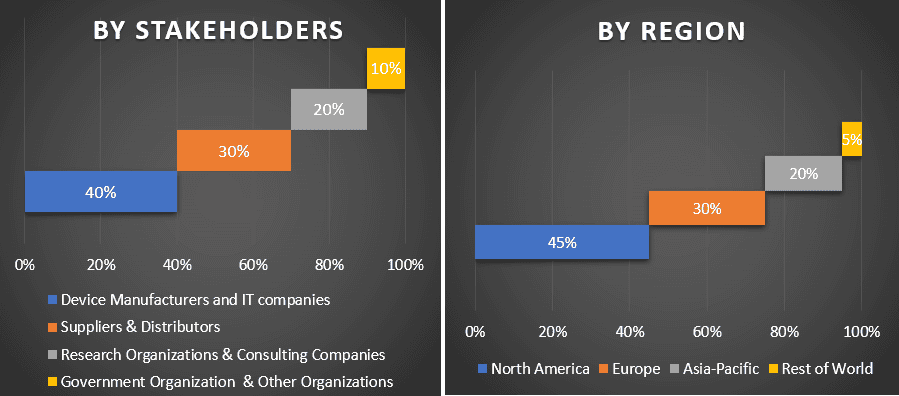
NÓI CHUYỆN VỚI CHUYÊN GIA PHÂN TÍCH
Kỹ thuật Thị trường
Kỹ thuật tam giác hóa dữ liệu đã được sử dụng để hoàn thành việc ước tính thị trường tổng thể và đưa ra các con số thống kê chính xác của từng phân khúc và phân đoạn phụ của thị trường trí tuệ nhân tạo (AI) trong chẩn đoán y tế. Dữ liệu được chia thành một số phân khúc và phân đoạn phụ sau khi nghiên cứu các thông số và xu hướng khác nhau trong các lĩnh vực loại sản phẩm và ứng dụng của thị trường trí tuệ nhân tạo (AI) trong chẩn đoán y tế.
Mục tiêu chính của Nghiên cứu Thị trường Trí tuệ nhân tạo (AI) trong Chẩn đoán Y tế
Các xu hướng thị trường hiện tại & tương lai của trí tuệ nhân tạo (AI) trong chẩn đoán y tế đã được xác định trong nghiên cứu. Các nhà đầu tư có thể thu được những hiểu biết sâu sắc chiến lược để làm cơ sở cho quyết định đầu tư của họ dựa trên phân tích định tính và định lượng được thực hiện trong nghiên cứu. Các xu hướng thị trường hiện tại và tương lai xác định sức hấp dẫn tổng thể của thị trường ở cấp độ khu vực, cung cấp một nền tảng cho người tham gia công nghiệp khai thác thị trường chưa được khai thác để hưởng lợi như một lợi thế đi đầu. Các mục tiêu định lượng khác của các nghiên cứu bao gồm:
- Phân tích quy mô thị trường hiện tại và dự báo của trí tuệ nhân tạo (AI) trong chẩn đoán y tế tính theo giá trị (USD). Ngoài ra, phân tích quy mô thị trường hiện tại và dự báo của các phân khúc và phân đoạn phụ khác nhau
- Các phân khúc trong nghiên cứu bao gồm các lĩnh vực thành phần, ứng dụng và người dùng cuối
- Xác định và phân tích khuôn khổ pháp lý cho ngành trí tuệ nhân tạo (AI) trong chẩn đoán y tế
- Phân tích chuỗi giá trị liên quan đến sự hiện diện của các trung gian khác nhau, cùng với việc phân tích hành vi của khách hàng và đối thủ cạnh tranh trong ngành
- Phân tích quy mô thị trường hiện tại và dự báo của thị trường trí tuệ nhân tạo (AI) trong chẩn đoán y tế cho khu vực chính
- Các khu vực chính được nghiên cứu trong báo cáo bao gồm Bắc Mỹ, Châu Âu, Châu Á - Thái Bình Dương và Phần còn lại của thế giới
- Hồ sơ công ty của thị trường trí tuệ nhân tạo (AI) trong chẩn đoán y tế và các chiến lược tăng trưởng được những người chơi trên thị trường áp dụng để duy trì vị thế trong thị trường đang phát triển nhanh chóng
- Phân tích chuyên sâu cấp độ khu vực của ngành
Liên quan Báo cáo
Khách hàng đã mua mặt hàng này cũng đã mua


